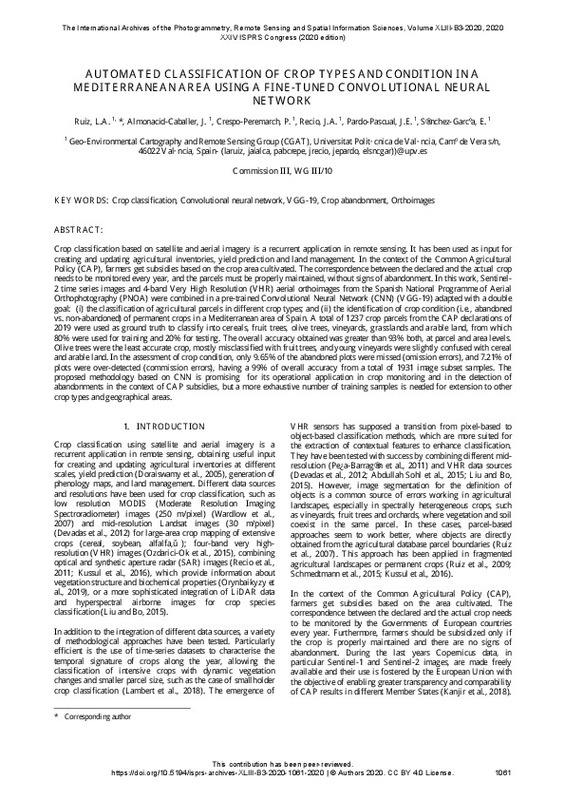JavaScript is disabled for your browser. Some features of this site may not work without it.
Buscar en RiuNet
Listar
Mi cuenta
Estadísticas
Ayuda RiuNet
Admin. UPV
Automated classification of crop types and condition in a mediterranean area using a fine-tuned convolutional neural network
Mostrar el registro completo del ítem
Ruiz Fernández, LÁ.; Almonacid-Caballer, J.; Crespo-Peremarch, P.; Recio Recio, JA.; Pardo Pascual, JE.; Sánchez-García, E. (2020). Automated classification of crop types and condition in a mediterranean area using a fine-tuned convolutional neural network. ISPRS. 1061-1068. https://doi.org/10.5194/isprs-archives-XLIII-B3-2020-1061-2020
Por favor, use este identificador para citar o enlazar este ítem: http://hdl.handle.net/10251/178915
Ficheros en el ítem
Metadatos del ítem
| Título: | Automated classification of crop types and condition in a mediterranean area using a fine-tuned convolutional neural network | |
| Autor: | ||
| Entidad UPV: |
|
|
| Fecha difusión: |
|
|
| Resumen: |
[EN] Crop classification based on satellite and aerial imagery is a recurrent application in remote sensing. It has been used as input for
creating and updating agricultural inventories, yield prediction and land management. ...[+]
|
|
| Palabras clave: |
|
|
| Derechos de uso: | Reconocimiento (by) | |
| Fuente: |
|
|
| DOI: |
|
|
| Editorial: |
|
|
| Versión del editor: | https://doi.org/10.5194/isprs-archives-XLIII-B3-2020-1061-2020 | |
| Título del congreso: |
|
|
| Lugar del congreso: |
|
|
| Fecha congreso: |
|
|
| Código del Proyecto: |
|
|
| Agradecimientos: |
This research has been funded by the Conselleria d'Agricultura,
Medi Ambient, Canvi Climàtic i Desenvolupament Rural,
Generalitat Valenciana, throught the nominative line S847000.
The authors also thank the Institut ...[+]
|
|
| Tipo: |
|









